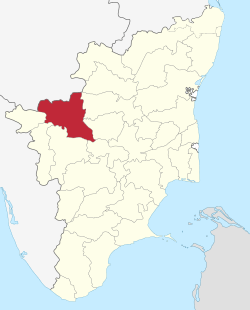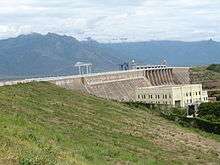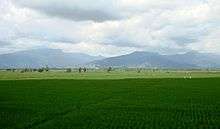Erode district
| Erode district ஈரோடு மாவட்டம் | |
|---|---|
| District | |
|
| |
 Location in Tamil Nadu, India | |
| Coordinates: 11°21′N 77°44′E / 11.350°N 77.733°ECoordinates: 11°21′N 77°44′E / 11.350°N 77.733°E | |
| Country | India |
| State | Tamil Nadu |
| Region | Western Tamil Nadu (Kongu Nadu) |
| Headquarters | Erode |
| Revenue Division | Erode, Gobichettipalayam |
| Government | |
| • Collector | S. Prabakharan IAS |
| Area | |
| • Total | 5,722 km2 (2,209 sq mi) |
| Population (2011) | |
| • Total | 2,251,744 |
| • Density | 397/km2 (1,030/sq mi) |
| Languages | |
| • Official | Tamil |
| Time zone | IST (UTC+5:30) |
| PIN | 638*** |
| Telephone code |
0424 (Erode) 04285 (Gobichettipalayam) 04256 (Bhavani) 04295 (Sathyamangalam) 04294 (Perundurai) |
| ISO 3166 code | ISO 3166-2:IN |
| Vehicle registration |
TN 33 (Erode East) TN 36 (Gobichettipalayam) TN 56 (Perundurai) TN 86 (Erode West) [1] |
| Largest city | Erode |
| Sex ratio | M-51%/F-49% ♂/♀ |
| Literacy | 72.96% |
| Lok Sabha seats | 3 |
| Vidhan Sabha seats | 8 |
| Central location: | 11°15′N 77°19′E / 11.250°N 77.317°E |
| Precipitation | 700 millimetres (28 in) |
| Avg. summer temperature | 35 °C (95 °F) |
| Avg. winter temperature | 18 °C (64 °F) |
| Website |
www |
Erode District (previously known as Periyar District) is a district in the Kongu Nadu region (western part) of the state of Tamil Nadu, India. It was the largest district by area in the state before the Formation of Tirupur District and the headquarters of the district is Erode. It is divided into two revenue divisions namely Erode and Gobichettipalayam and further subdivided into 9 taluks. Periyar district was a part of Coimbatore District before its division into two on September 17, 1979 and was renamed as Erode District in 1996. As of 2011, the district had a population of 2,251,744 with a sex-ratio of 993 females for every 1,000 males, much above the national average of 929.
History
The region belonging to the present day districts were ruled successively by several dynasties of South India including the Cheras, Cholas and Pandyas. It was under the rule of Cheras in the first millennium and various rulers. During the 10th to 12th centuries the region was part of the larger Chola Empire.
The region became part of Vijayanagara empire in 1300's, later under Nayaks of Madurai until 17th century. Under the Madurai Nayaks, the Polygar system of administration was established, who were the Governors of the region. Since mid 17th century the region was part of Kingdom of Mysore but continuing the Polygar system of administration.
The Polygar chieftain Dheeran Chinnamalai was one of the governors of the region, who played a major part in the early struggle for Indian Independence in the Polygar Wars against the British East India Company. After the Polygar and Mysore wars in the late 18th century, the area came under control of the British until the Indian Independence in 1947. It was a part of the erstwhile Coimbatore district until its bifurcation in 1979.
Demographics
According to 2011 census, Erode district had a population of 2,251,744 with a sex-ratio of 993 females for every 1,000 males, much above the national average of 929.[2] A total of 195,213 were under the age of six, constituting 99,943 males and 95,270 females. Scheduled Castes and Scheduled Tribes accounted for 16.41% and .97% of the population respectively. The average literacy of the district was 66.29%, compared to the national average of 72.99%.[2] The district had a total of 658,071 households. There were a total of 1,195,773 workers, comprising 173,376 cultivators, 331,414 main agricultural labourers, 48,960 in house hold industries, 557,301 other workers, 84,722 marginal workers, 4,794 marginal cultivators, 38,798 marginal agricultural labourers, 5,362 marginal workers in household industries and 35,768 other marginal workers.[3]
Geography

The district is bounded by Chamarajanagar district of Karnataka to the north, and by Kaveri River to the east. Across the river lies Salem, Namakkal and Karur districts. Tirupur District lies immediately to the south, and Coimbatore and the Nilgiris district lie to the west. Erode District is landlocked and is situated at between 10 36” and 11 58” north latitude and between 76 49” and 77 58” east longitude. The district forms the meeting point of Western Ghats and Eastern Ghats separated by Bhavani River.
The district comprises a long undulating plain, sloping gently towards the Kaveri River in the south-east. Three major tributaries of river Kaveri, the Bhavani, Noyyal and Amaravati, run across the long stretch of mountains in the north. Palar River constitutes the boundary between Erode district and Karnataka in the north. The Bhavanisagar Dam and Kodiveri Dam provide storage facilities and numerous canals along with these rivers provide proper drainage and facilities for irrigation in the district.

Bhavani River
Bhavani rises in the Western Ghats of Silent Valley National Park in Palakkad District of Kerala. It receives the Siruvani River which has the second tastiest water in the world, a perennial stream of Coimbatore District, and gets reinforced by the Kundah river before entering Erode District in Sathyamangalam. Bhavani is more or less a perennial river fed mostly by the southwest monsoon. The northeast monsoon also supplements its water resources. This river runs for over hundred miles through Erode District, traversing Bhavani and Gobichettipalayam taluks. It feeds the Bhavanisagar reservoir, which takes an easterly course after Sathyamangalam taluk. Near Gobichettipalayam lies the Kodiveri Dam, a mini dam constructed for agricultural purposes. It ultimately joins Kaveri in the island of Bhavani, Tamil Nadu, near Erode, with a holistic tributary river of Amutha Nathi, hence called Tiriveni Sangamam. The place where Bhavani joins with Kaveri River is famous for Sri Sangameshwara Temple of Lord Shiva, where according to the Hindu customs people perform the last rights for deceased near and dears.
Kaveri River
Kaveri rises in the Western Ghats of Kodagu (Coorg) District, in Karnataka, and is joined by many small tributaries. It runs eastward through Karnataka, and at Hogenakal fall takes a sharp turn, east to south. Before reaching this point, it is joined by its main tributary, the Kabini River. From here it runs towards the southeast, forming the boundary between Bhavani Taluk of Erode District and Tiruchengode Taluk of the neighbouring Namakkal District. The Bhavani River joins the Kaveri at the town of Bhavani.
Climate
The climate is mostly dry and characterized by good rainfall. Unlike nearby Coimbatore district, Erode District has dry weather throughout the year except during the monsoons. The Palghat Gap in Western Ghats, which has a moderating effect on the climate of Coimbatore district, does not help in bringing down the dry climate in this area. The cool moist wind that gushes out of the west coast through Palghat gap loses its coolness and becomes dry by the time it crosses Coimbatore district and reaches Erode. Generally the first two months of the year are pleasant, but in March the temperature begins to rise, which persists till the end of May. The highest temperatures are normally recorded during May. The scanty showers during this period do not provide much relief from the oppressive heat. However, there is an improvement in the climate during the June–August period. During the pre-monsoon period, the temperature reverses its trend. By September the sky gets heavily overcast, although the rains pour down. The northeast monsoon sets in vigorously only during October–November, and by December the rains disappear, rendering the climate clear and cold.
Administration

Erode District is divided into two revenue divisions namely: Erode and Gobichettipalayam. The district presently contains nine taluks namely: Anthiyur, Bhavani, Erode, Gobichettipalayam, Perundurai, Satyamangalam, Modakurichi, Kodumudi and Thalavadi .[4][5] Erode District consists of the municipal corporation of Erode and four other municipalities:[6]
- Selection Grade: Gobichettipalayam
- Grade I: Sathyamangalam
- Grade II: Bhavani, Punjai Puliampatti
Politics
Erode District is divided between 3 Parliamentary Constituencies namely: Erode, Nilgiris and Tirupur. The district consists of 8 assembly constituencies namely Anthiyur, Bhavani, Bhavani Sagar, Erode East, Erode West, Gobichettipalayam, Modakurichi and Perundurai.
| Assembly Constituency |
Political Party |
Elected Representative | |||||||||||||||||||||||||||||||||||||||||||||||||
|---|---|---|---|---|---|---|---|---|---|---|---|---|---|---|---|---|---|---|---|---|---|---|---|---|---|---|---|---|---|---|---|---|---|---|---|---|---|---|---|---|---|---|---|---|---|---|---|---|---|---|---|
| |||||||||||||||||||||||||||||||||||||||||||||||||||


